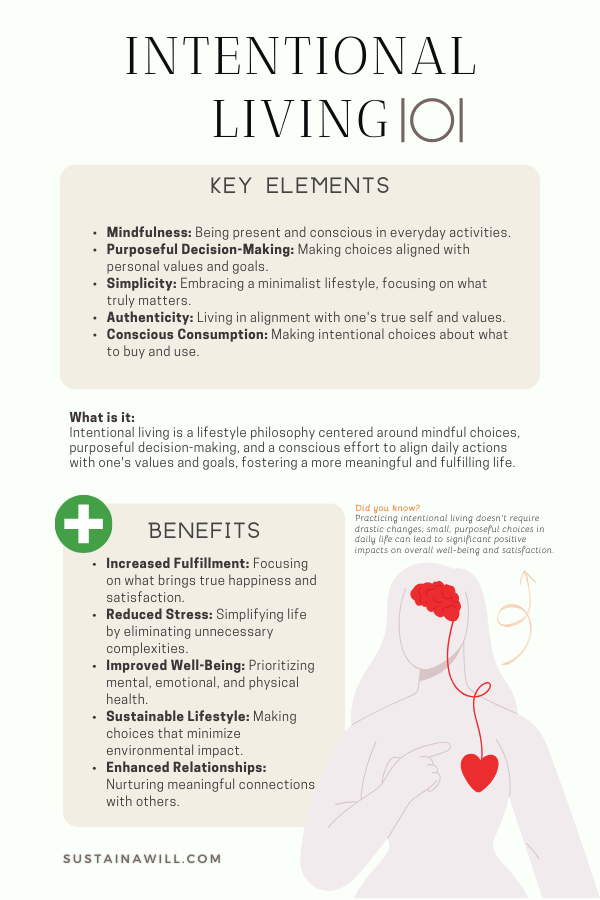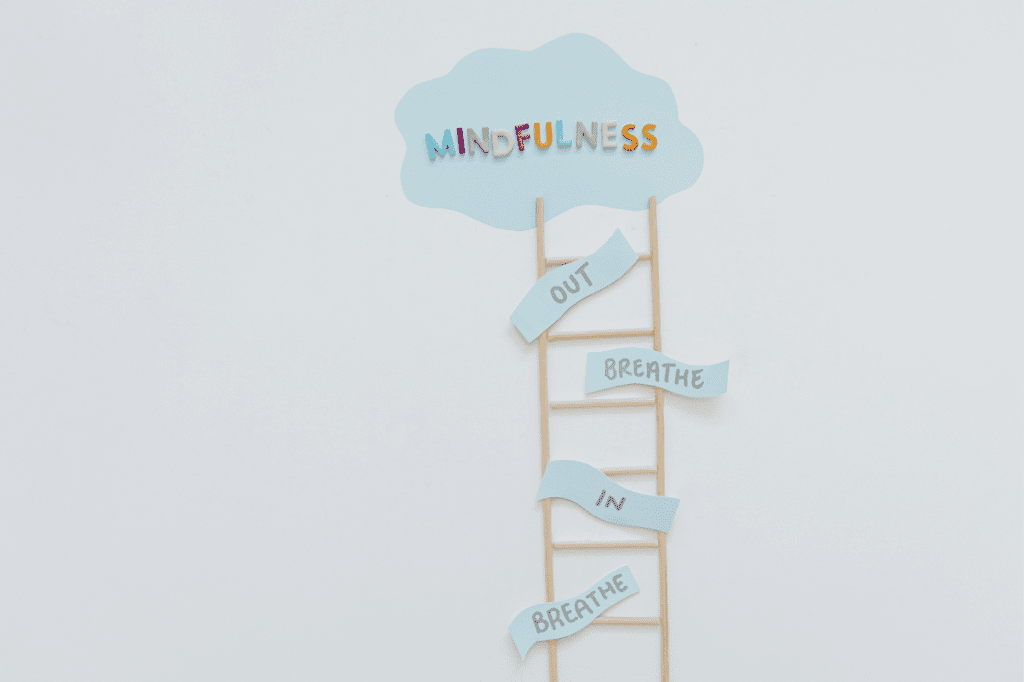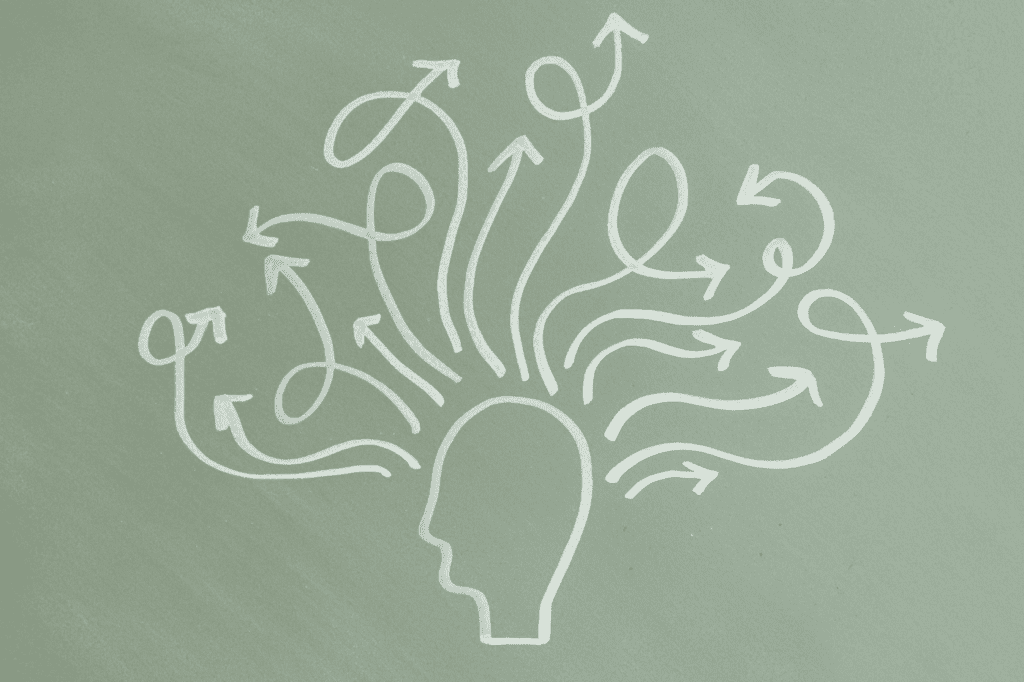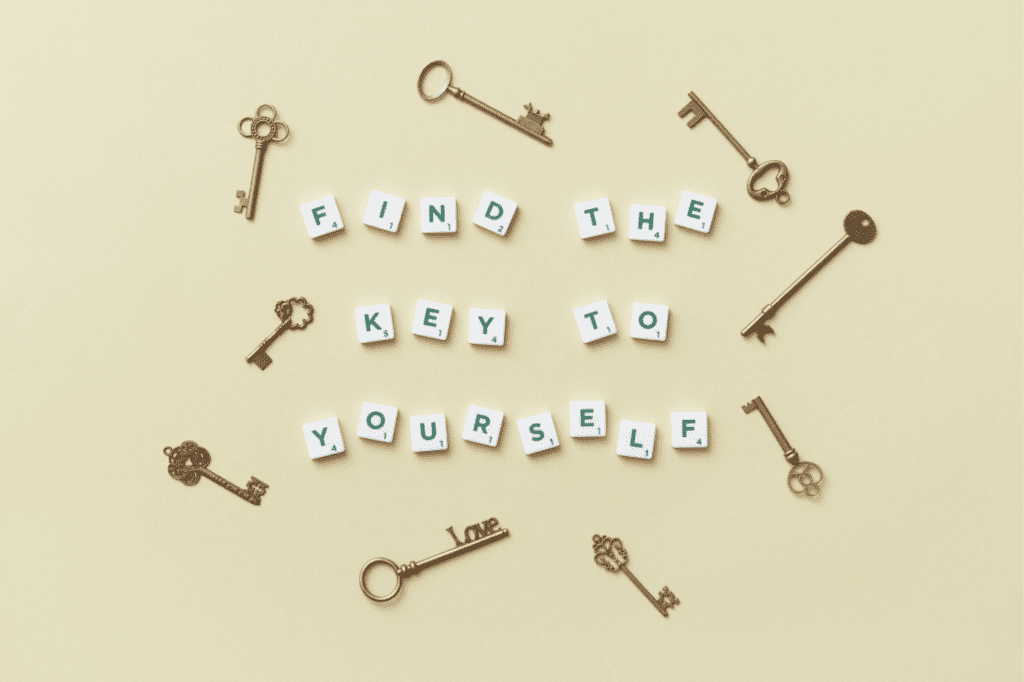Life’s racing ahead, and you’re just trying to keep up? If you’ve ever wondered how to inject purpose into your daily chaos, you’re in the right place.
In “What Is Intentional Living? 13 Easy Ways,” we’ll unravel the secrets to living with purpose, aligning your choices with your true goals, and finding meaning in the everyday grind.
Say goodbye to feeling lost or questioning your path—our guide is here to bring clarity, one intentional step at a time. Ready to transform chaos into purpose? Let’s dive in!
What is Intentional Living?

Intentional living is about making thoughtful choices that match what you really care about and want to achieve in life. It’s creating a life that feels clear, meaningful, and fulfilling by being purposeful in your decisions.
Key Components
- Clarifying Values:
- Intentional living starts with knowing what truly matters to you. What are your core values, beliefs, and priorities? This clarity becomes your compass.
- Setting Clear Goals:
- Once you know your values, intentional living involves setting specific, meaningful goals that align with those values. These goals become your roadmap.
- Mindful Decision-Making:
- It’s about being present in each moment and making decisions that resonate with your values and goals. Mindfulness helps you avoid drifting along with the currents.
- Simplifying Life:
- Intentional living often includes simplifying your life. It’s about decluttering—both physically and mentally—to focus on what truly matters.
- Balancing Priorities:
- Recognizing that you can’t do everything at once, intentional living involves prioritizing. It’s about finding a balance that brings fulfillment without overwhelming yourself.
- Living in Alignment:
- Your actions and choices align with your values and goals. This creates a sense of purpose and authenticity in your daily life.
- Cultivating Gratitude:
- Intentional living encourages gratitude. Appreciating what you have fosters contentment and a positive outlook on life.
Why should I live intentionally?

Authenticity
You steer away from societal expectations, choosing to live in a way that genuinely represents your true self.
Fulfillment
By aligning your daily actions with your core values, intentional living leads to a profound sense of satisfaction and fulfillment in your life.
Reduced Stress
The choices we make in intentional living help reduce stress and bring order to our lives. Research, like a study conducted with college students found here, discovered that when we take actions based on our values, we get better at handling tough times.
So, by living intentionally, we not only make life less chaotic but also become more resilient in facing stress.
Meaningful Connections
Relationships take on a deeper significance as intentional living prompts you to invest time and energy in connections that truly matter, fostering authentic and meaningful bonds.
Personal Growth
Intentional living is not a destination but a continuous journey. It becomes a pathway for ongoing self-discovery and personal growth, creating a life that evolves in sync with your aspirations and values.
In essence, intentional living is about taking the driver’s seat of your life, navigating with purpose, and savoring each moment along the way. It’s a mindful, proactive approach to living the life you envision.
How do you practice intentional living?

Here are 13 easy ways to practice intentional living and bring more purpose into your daily life:
1. Define Your Values
Take time to identify your core values. What matters most to you? Knowing your values provides a foundation for intentional living.
How to: Define Your Values
- Reflect on What Matters Most:
- Take a moment to ponder what truly matters to you in life. Consider your beliefs, principles, and the aspects that bring you genuine joy.
- Identify Core Values:
- List down the values that consistently stand out as essential to your sense of self and fulfillment. These could range from family and integrity to creativity and adventure.
Example
If family is a core value, you might prioritize spending quality time with your loved ones over other commitments.
2. Set Clear Goals
Establish specific and achievable goals aligned with your values. These goals will guide your decisions and actions.
How to: Set Clear Goals
- Connect Goals to Values:
- Consider how your goals align with your core values. Ensure that each goal reflects a facet of what truly matters to you.
- Be Specific and Achievable:
- Frame your goals in clear, specific terms. Break them down into manageable steps to make them more achievable.
Example
If a health goal aligns with your values, set a specific target, like walking for 30 minutes each day.
3. Prioritize Your Time
Identify your priorities and allocate your time accordingly. Focus on activities that align with your values and goals.
How to: Prioritize Your Time
- Clarify Your Priorities:
- Identify the key areas of your life that align with your values and goals. What matters most to you?
- Allocate Time Strategically:
- Once you’ve identified priorities, allocate your time in a way that reflects their importance. Focus on activities that resonate with your values.
Example
If personal growth is a priority, allocate time each week for reading or attending a course.
4. Mindful Decision-Making
Before making decisions, pause and consider whether they align with your values and goals. Mindful decision-making is a key aspect of intentional living.
How to: Mindful Decision-Making
- Create Decision-Making Space:
- Intentionally build pauses into your decision-making process. This could be a few deep breaths, a short walk, or a moment of reflection.
- Align Decisions with Values:
- Consider whether the decision at hand aligns with your core values and overarching goals. Does it contribute positively to your life’s direction?
Example
Before agreeing to additional work commitments, consider if they align with your long-term career goals and personal values.
5. Declutter Your Space
Clear out physical clutter in your living and working spaces. A tidy environment can positively impact your mental clarity and focus.
How to: Declutter Your Space
- Start Small:
- Tackle one area at a time, whether it’s a desk, a room, or a specific corner. Breaking it down makes the task more manageable.
- Create “Keep,” “Donate,” and “Discard” Piles:
- Categorize items into these three groups. Keep what’s essential, consider donating things you no longer need, and discard items that serve no purpose.
Example
Regularly declutter your desk or living room to create a clean and organized environment that supports focus and well-being.
6. Simplify Your Commitments
Assess your commitments and activities. Simplify by saying no to those that don’t align with your values or contribute to your goals.
How to: Simplify Your Commitments
- Audit Your Commitments:
- List your current commitments and activities. What are you dedicating time to, and do they align with your values and goals?
- Prioritize Joy and Fulfillment:
- Identify the commitments that truly bring you joy and contribute to your sense of fulfillment. Consider scaling back on those that don’t align with your values.
Example
If you’re involved in numerous social groups, evaluate their impact on your well-being. Simplify by focusing on the ones that genuinely bring you joy and fulfillment.
7. Practice Gratitude Daily
Take a moment each day to reflect on what you’re grateful for. Cultivating gratitude can shift your focus to the positive aspects of your life.
How to: Practice Gratitude Daily
- Establish a Routine:
- Incorporate a gratitude practice into your daily routine. Whether it’s in the morning, before bed, or during breaks, consistency is key.
- Identify Three Gratitudes:
- Reflect on and jot down three things you’re grateful for each day. They can range from simple pleasures to significant moments.
Example
Each morning, take a moment to jot down three things you’re grateful for, whether it’s a beautiful sunrise or a supportive friend.
8. Create a Morning Routine
Start your day with intention by establishing a morning routine. It can include activities that set a positive tone for the day.
How to: Create a Morning Routine
- Identify Positive Activities:
- Choose activities that resonate with you and set a positive tone for your day. This could include stretching, reading, or enjoying a quiet moment.
- Establish Consistency:
- Make your morning routine a consistent part of your day. Whether it’s 10 minutes or an hour, the key is regularity.
Example
Start your day intentionally by incorporating activities like stretching, reading a positive quote, or enjoying a mindful cup of tea.
9. Embrace Mindfulness
Incorporate mindfulness practices into your daily life. Whether it’s meditation, deep breathing, or simply being present in the moment, mindfulness enhances intentional living.
How to: Embrace Mindfulness
- Choose Mindfulness Techniques:
- Identify mindfulness practices that resonate with you, whether it’s meditation, deep breathing, or simply being fully present.
- Integrate into Daily Life:
- Incorporate mindfulness into your daily routine. It could be during breaks, while commuting, or as a dedicated practice.
Example
Amidst a busy workday, intentionally take short breaks for deep breathing exercises. This mindful pause helps you stay present, reduces stress, and infuses moments of calm into your day, aligning with the principles of intentional living.
10. Regularly Reflect
Set aside time for reflection. Regularly assess your progress, reassess your goals, and make adjustments as needed.
How to: Regularly Reflect
- Schedule Reflection Time:
- Dedicate specific moments, whether weekly or monthly, for intentional reflection. It could be a set time or linked to a recurring event.
- Assess Progress and Adjust:
- During reflection, evaluate your progress toward goals. Adjust strategies and set new intentions based on your evolving aspirations.
Example
Set aside time each month to reflect on your progress toward your goals, adjusting strategies if needed.
11. Set Boundaries
Establish clear boundaries to protect your time and energy. Saying no when necessary is a powerful way to maintain balance.
How to: Set Boundaries
- Define Your Limits:
- Clearly articulate your personal and professional limits. Understand what is essential for your well-being.
- Practice Saying No:
- Develop the ability to say no when necessary. It’s a powerful tool for protecting your time and energy.
Example
Learn to say no when additional work tasks conflict with personal time needed to recharge and maintain work-life balance.
12. Invest in Relationships
Nurture meaningful connections. Spend time with people who uplift and support you, fostering positive relationships.
How to: Invest in Relationships
- Identify Key Connections:
- Recognize the relationships that bring positivity and support to your life. Focus on nurturing these connections.
- Allocate Quality Time:
- Schedule intentional moments to spend with friends or loved ones. Regular interaction strengthens relationships.
Example
Schedule regular coffee dates with close friends to strengthen your connections and maintain a supportive social network.
This intentional investment in relationships ensures that your time is dedicated to those who uplift and contribute positively to your life.
13. Celebrate Small Wins
Acknowledge and celebrate your achievements, no matter how small. Recognizing progress reinforces the positive aspects of intentional living.
How to: Celebrate Small Wins
- Acknowledge Achievements:
- Regularly recognize and acknowledge your accomplishments, regardless of their size. Celebrate the journey as well as the destination.
- Reward Yourself:
- Take intentional moments to reward yourself for your efforts. Small gestures can reinforce the positive impact of your intentional choices.
Example
If you complete a challenging task at work, take a moment to acknowledge your accomplishment and treat yourself to a small reward.
Remember, intentional living is a continuous journey, and it’s okay to adapt and evolve along the way. These simple practices can help you infuse purpose into your daily life and create a more intentional, fulfilling existence.
30 Days Intentional Living Challenge

For the next month, commit to incorporating intentional living practices into your daily routine. Here’s your 30-day challenge:
Week 1: Define Your Foundation
Day 1-3: Identify Your Values
List three core values that are truly important to you.
Day 4-7: Set Clear Goals
Establish one specific goal for each value identified.
Week 2: Mindful Decision-Making
Day 8-10: Pause Before Deciding
Take a moment to reflect before making decisions. Consider how each choice aligns with your values and goals.
Day 11-14: Simplify Commitments
Assess your current commitments and let go of one that doesn’t align with your values.
Week 3: Creating a Mindful Environment
Day 15-17: Declutter Your Space
Dedicate time to decluttering a specific area in your home or workspace.
Day 18-21: Establish a Morning Routine
Develop a morning routine that sets a positive tone for your day.
Week 4: Reflection and Gratitude
Day 22-24: Reflect on Your Journey
Take time to reflect on the changes you’ve made and their impact.
Day 25-28: Practice Gratitude Daily
Each day, write down three things you’re grateful for.
Final Day: Celebrate Your Progress
Day 29-30: Acknowledge Small Wins
Celebrate your achievements, recognizing the progress you’ve made.
This challenge is designed to kickstart your intentional living practices but feel free to customize it based on your needs and preferences. Embrace the challenge, stay mindful, and enjoy the transformation in your daily life!
Intentional Living Vs Other Mentalities

Is intentional living the same as minimalism?
Well, not quite, but they’re like two awesome teammates working towards a common goal. Let me break it down for you:
Intentional Living
- Think of intentional living as your life’s GPS. It’s all about living with purpose, aligning your actions with what truly matters to you—your values, your goals, and your vision for a fulfilling life.
Minimalism
- Now, minimalism is like your life’s Marie Kondo. It’s about simplifying, decluttering, and focusing on what adds real value. Less stuff, more meaning.
How They Connect
- While intentional living covers the whole spectrum of life, minimalism is more about simplifying physically. But here’s the cool part—they’re buddies. Many intentional livers embrace minimalism to clear the way for what truly matters.
The Challenge
- Here’s a challenge for you: Try incorporating intentional living and maybe sprinkle in a bit of minimalism for the next month. See how it feels. Reflect on what truly brings joy and meaning to your life.
So, are you ready to embrace a life that’s not just intentional but also beautifully uncluttered? It’s your story to write, and intentional living and minimalism can be some powerful chapters. Go ahead, give it a try!
What is the difference between intentional living and mindful living?
While intentional living and mindful living have different emphases, they can harmoniously coexist. Many intentional living practices include mindfulness, emphasizing the importance of being present in each intentional choice.
The sweet spot is finding a balance between being fully present in the moment (mindful living) and actively shaping your life with purpose (intentional living).
Intentional Living
- Purposeful Living:
- Living with a clear purpose, aligning actions with values and goals.
- Goal-Oriented:
- Involves setting specific, meaningful goals for a strategic life path.
- Individualized Approach:
- Highly personal, allowing flexibility and personalization.
Mindful Living
- Present Moment Awareness:
- Focuses on being fully present in the current moment.
- Non-Judgmental:
- Observe thoughts and feelings without judgment.
- Cultivates Awareness:
- Incorporates mindfulness into daily activities.
What is the difference between intentional living and slow living?
While intentional living and slow living have distinct focuses, they share common values. Both emphasize mindfulness, purposeful choices, and a deeper connection with life.
Many intentional living practitioners incorporate elements of slow living into their lifestyle. The deliberate pace and mindfulness of slow living can enhance the intentional pursuit of goals.
Intentional Living
- Purposeful Direction:
- Living with clear goals and choices aligned with values for a deliberate and balanced life.
- Proactive Approach:
- Taking charge, making decisions that contribute to overall well-being.
Slow Living
- Embracing a Slower Pace:
- Choosing a deliberate, unhurried lifestyle focused on mindful presence and quality experiences.
- Connection with Nature:
- Reconnecting with nature and embracing a holistic way of living.
Conclusion
Ready to take that first step? Declutter your mind, set clear goals—and embrace intentional living. Your life, intentionally crafted, awaits your next move. What will it be?








